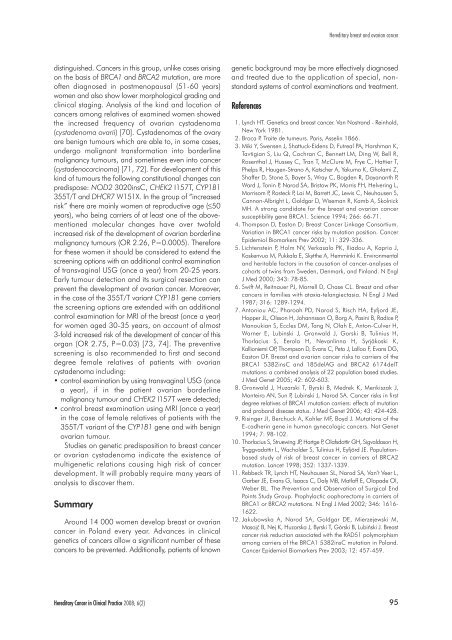<strong>Hereditary</strong> <strong>breast</strong> <strong>and</strong> <strong>ovarian</strong> <strong>cancer</strong>distinguished. Cancers in this group, unlike cases arisingon the basis of BRCA1 <strong>and</strong> BRCA2 mutation, are moreoften diagnosed in postmenopausal (51-60 years)women <strong>and</strong> also show lower morphological grading <strong>and</strong>clinical staging. Analysis of the kind <strong>and</strong> location of<strong>cancer</strong>s among relatives of examined women showedthe increased frequency of <strong>ovarian</strong> cystadenoma(cystadenoma ovarii) [70]. Cystadenomas of the ovaryare benign tumours which are able to, in some cases,undergo malignant transformation into borderlinemalignancy tumours, <strong>and</strong> sometimes even into <strong>cancer</strong>(cystadenocarcinoma) [71, 72]. For development of thiskind of tumours the following constitutional changes canpredispose: NOD2 3020insC, CHEK2 I157T, CYP1B1355T/T <strong>and</strong> DHCR7 W151X. In the group of “increasedrisk” there are mainly women at reproductive age (≤50years), who being carriers of at least one of the abovementionedmolecular changes have over twofoldincreased risk of the development of <strong>ovarian</strong> borderlinemalignancy tumours (OR 2.26, P=0.0005). Thereforefor these women it should be considered to extend thescreening options with an additional control examinationof transvaginal USG (once a year) from 20-25 years.Early tumour detection <strong>and</strong> its surgical resection canprevent the development of <strong>ovarian</strong> <strong>cancer</strong>. Moreover,in the case of the 355T/T variant CYP1B1 gene carriersthe screening options are extended with an additionalcontrol examination for MRI of the <strong>breast</strong> (once a year)for women aged 30-35 years, on account of almost3-fold increased risk of the development of <strong>cancer</strong> of thisorgan (OR 2.75, P=0.03) [73, 74]. The preventivescreening is also recommended to first <strong>and</strong> seconddegree female relatives of patients with <strong>ovarian</strong>cystadenoma including:• control examination by using transvaginal USG (oncea year), if in the patient <strong>ovarian</strong> borderlinemalignancy tumour <strong>and</strong> CHEK2 I157T were detected;• control <strong>breast</strong> examination using MRI (once a year)in the case of female relatives of patients with the355T/T variant of the CYP1B1 gene <strong>and</strong> with benign<strong>ovarian</strong> tumour.Studies on genetic predisposition to <strong>breast</strong> <strong>cancer</strong>or <strong>ovarian</strong> cystadenoma indicate the existence ofmultigenetic relations causing high risk of <strong>cancer</strong>development. It will probably require many years ofanalysis to discover them.SummaryAround 14 000 women develop <strong>breast</strong> or <strong>ovarian</strong><strong>cancer</strong> in Pol<strong>and</strong> every year. Advances in clinicalgenetics of <strong>cancer</strong>s allow a significant number of these<strong>cancer</strong>s to be prevented. Additionally, patients of knowngenetic background may be more effectively diagnosed<strong>and</strong> treated due to the application of special, nonst<strong>and</strong>ardsystems of control examinations <strong>and</strong> treatment.References1. Lynch HT. Genetics <strong>and</strong> <strong>breast</strong> <strong>cancer</strong>. Van Nostr<strong>and</strong> - Reinhold,New York 1981.2. Broca P. Traite de tumeurs. Paris, Asselin 1866.3. Miki Y, Swensen J, Shattuck-Eidens D, Futreal PA, Harshman K,Tavtigian S, Liu Q, Cochran C, Bennett LM, Ding W, Bell R,Rosenthal J, Hussey C, Tran T, McClure M, Frye C, Hattier T,Phelps R, Haugen-Strano A, Katscher A, Yakumo K, Gholami Z,Shaffer D, Stone S, Bayer S, Wray C, Bogden R, Dayananth P,Ward J, Tonin P, Narod SA, Bristow PK, Morris FH, Helvering L,Morrisom P, Rosteck P, Lai M, Barrett JC, Lewis C, Neuhausen S,Cannon-Albright L, Goldgar D, Wiseman R, Kamb A, SkolnickMH. A strong c<strong>and</strong>idate for the <strong>breast</strong> <strong>and</strong> <strong>ovarian</strong> <strong>cancer</strong>susceptibility gene BRCA1. Science 1994; 266: 66-71.4. Thompson D, Easton D; Breast Cancer Linkage Consortium.Variation in BRCA1 <strong>cancer</strong> risks by mutation position. CancerEpidemiol Biomarkers Prev 2002; 11: 329-336.5. Lichtenstein P, Holm NV, Verkasalo PK, Iliadou A, Kaprio J,Koskenvuo M, Pukkala E, Skytthe A, Hemminki K. Environmental<strong>and</strong> heritable factors in the causation of <strong>cancer</strong>-analyses ofcohorts of twins from Sweden, Denmark, <strong>and</strong> Finl<strong>and</strong>. N EnglJ Med 2000; 343: 78-85.6. Swift M, Reitnauer PJ, Morrell D, Chase CL. Breast <strong>and</strong> other<strong>cancer</strong>s in families with ataxia-telangiectasia. N Engl J Med1987; 316: 1289-1294.7. Antoniou AC, Pharoah PD, Narod S, Risch HA, Eyfjord JE,Hopper JL, Olsson H, Johannsson O, Borg A, Pasini B, Radice P,Manoukian S, Eccles DM, Tang N, Olah E, Anton-Culver H,Warner E, Lubinski J, Gronwald J, Gorski B, Tulinius H,Thorlacius S, Eerola H, Nevanlinna H, Syrjäkoski K,Kallioniemi OP, Thompson D, Evans C, Peto J, Lalloo F, Evans DG,Easton DF. Breast <strong>and</strong> <strong>ovarian</strong> <strong>cancer</strong> risks to carriers of theBRCA1 5382insC <strong>and</strong> 185delAG <strong>and</strong> BRCA2 6174delTmutations: a combined analysis of 22 population based studies.J Med Genet 2005; 42: 602-603.8. Gronwald J, Huzarski T, Byrski B, Medrek K, Menkiszak J,Monteiro AN, Sun P, Lubinski J, Narod SA. Cancer risks in firstdegree relatives of BRCA1 mutation carriers: effects of mutation<strong>and</strong> prob<strong>and</strong> disease status. J Med Genet 2006; 43: 424-428.9. Risinger JI, Berchuck A, Kohler MF, Boyd J. Mutations of theE-cadherin gene in human gynecologic <strong>cancer</strong>s. Nat Genet1994; 7: 98-102.10. Thorlacius S, Struewing JP, Hartge P, Olafsdottir GH, Sigvaldason H,Tryggvadottir L, Wacholder S, Tulinius H, Eyfjörd JE. Populationbasedstudy of risk of <strong>breast</strong> <strong>cancer</strong> in carriers of BRCA2mutation. Lancet 1998; 352: 1337-1339.11. Rebbeck TR, Lynch HT, Neuhausen SL, Narod SA, Van’t Veer L,Garber JE, Evans G, Isaacs C, Daly MB, Matloff E, Olopade OI,Weber BL. The Prevention <strong>and</strong> Observation of Surgical EndPoints Study Group. Prophylactic oophorectomy in carriers ofBRCA1 or BRCA2 mutations. N Engl J Med 2002; 346: 1616-1622.12. Jakubowska A, Narod SA, Goldgar DE, Mierzejewski M,Masojæ B, Nej K, Huzarska J, Byrski T, Górski B, Lubiñski J. Breast<strong>cancer</strong> risk reduction associated with the RAD51 polymorphismamong carriers of the BRCA1 5382insC mutation in Pol<strong>and</strong>.Cancer Epidemiol Biomarkers Prev 2003; 12: 457-459.<strong>Hereditary</strong> Cancer in Clinical Practice 2008; 6(2) 95
Jacek Gronwald, Tomasz Byrski, Tomasz Huzarski, Oleg Oszurek, Anna Janicka, Jolanta Szymañska-Pasternak, Bohdan Górski, Janusz Menkiszak, Izabella Rzepka-Górska, Jan Lubiñski13. Jakubowska A, Gronwald J, Menkiszak J, Górski B, Huzarski T,Byrski T, Edler L, Lubiñski J, Scott RJ, Hamann U. The RAD51135 G>C polymorphism modifies <strong>breast</strong> <strong>cancer</strong> <strong>and</strong> <strong>ovarian</strong><strong>cancer</strong> risk in Polish BRCA1 mutation carriers. Cancer EpidemiolBiomarkers Prev 2007; 16: 270-275.14. Risch HA, McLaughlin JR, Cole DE, Rosen B, Bradley L, Kwan E,Jack E, Vesprini DJ, Kuperstein G, Abrahamson JL, Fan I, Wong B,Narod SA. Prevalence <strong>and</strong> penetrance of germline BRCA1 <strong>and</strong>BRCA2 mutations in a population series of 649 women with<strong>ovarian</strong> <strong>cancer</strong>. Am J Hum Genet 2001; 68: 700-710.15. Marcus JN, Watson P, Page DL, Narod SA, Lenoir GM, Tonin P,Linder-Stephenson L, Salerno G, Conway TA, Lynch HT.<strong>Hereditary</strong> <strong>breast</strong> <strong>cancer</strong>: pathobiology, prognosis, <strong>and</strong> BRCA1<strong>and</strong> BRCA2 gene linkage. Cancer 1996; 77: 697-709.16. Martin AM, Blackwood MA, Antin-Ozerkis D, Shih HA, Calzone K,Colligon TA, Seal S, Collins N, Stratton MR, Weber BL,Nathanson KL. Germline mutations in BRCA1 <strong>and</strong> BRCA2 in<strong>breast</strong>-<strong>ovarian</strong> families from a <strong>breast</strong> <strong>cancer</strong> risk evaluationclinic. J Clin Oncol 2001; 19: 2247-2253.17. Li FP, Fraumeni JF Jr. Soft-tissue sarcomas, <strong>breast</strong> <strong>cancer</strong> <strong>and</strong>other neoplasms. A familial syndrome? Ann Intern Med 1969;71: 747-752.18. Menkiszak J, Jakubowska A, Gronwald J, Rzepka-Górska I,Lubiñski J. <strong>Hereditary</strong> <strong>ovarian</strong> <strong>cancer</strong>: summary of 5 years ofexperience. Ginekol Pol 1998; 69: 283-287.19. Loman N, Johannsson O, Bendahl P, Dahl N, Einbeigi Z, Gerdes A,Borg A, Olsson H. Prognosis <strong>and</strong> clinical presentation of BRCA2-associated <strong>breast</strong> <strong>cancer</strong>. Eur J Cancer 2000; 36: 1365-1373.20. Lubiñski J, Górski B, Huzarski T, Byrski T, Gronwald J, Serrano-Fernández P, Domaga³a W, Chosia M, Uciñski M, Grzybowska E,Lange D, Maka B, Mackiewicz A, Karczewska A, Breborowicz J,Lamperska K, Stawicka M, Gozdecka-Grodecka S, Bebenek M,Sorokin D, Wojnar A, Haus O, Sir J, Mierzwa T, Niepsuj S,Guga³a K, GóŸdŸ S, Sygut J, Kozak-Klonowska B, Musiatowicz B,Posmyk M, Kordek R, Morawiec M, Zambrano O, Waœko B, Fudali L,Skret J, Surdyka D, Urbañski K, Mituœ J, Ryœ J, Szwiec M, RozmiarekA, Dziuba I, W<strong>and</strong>zel P, Wiœniowski R, Szczylik C, Kozak A,Koz³owski W, Narod SA. BRCA1-positive <strong>breast</strong> <strong>cancer</strong>s in youngwomen from Pol<strong>and</strong>. Breast Cancer Res Treat 2006; 99: 71-76.21. Lakhani SR. The pathology of familial <strong>breast</strong> <strong>cancer</strong>:Morphological aspects. Breast Cancer Res 1999; 1: 31-35.22. Górski B, Byrski T, Huzarski T, Jakubowska A, Menkiszak J,Gronwald J, P³u¿añska A, Bêbenek M, Fischer-Maliszewska L,Grzybowska E, Narod SA, Lubiñski J. Founder mutations in theBRCA1 gene in Polish families with <strong>breast</strong>-<strong>ovarian</strong> <strong>cancer</strong>. AmJ Hum Genet 2000; 66: 1963-1968.23. Loman N, Johannsson O, Bendahl PO, Borg A, Fernö M,Olsson H. Steroid receptors in hereditary <strong>breast</strong> carcinomasassociated with BRCA1 or BRCA2 mutations or unknownsusceptibility genes. Cancer 1998; 83: 310-319.24. Wooster R, Neuhausen SL, Mangion J, Quirk Y, Ford D, Collins N,Nguyen K, Seal S, Tran T, Averill D, Fields P, Marshall G, Narod SA,Lenoir GM, Lynch H, Feunteun J, Devilee P, Cornelisse CJ,Menko FH, Daly PA, Ormiston W, McManus R, Pye C, Lewis CM,Cannon-Albright LA, Peto J, Ponder BAJ, Skolnick MH, Easton DF,Goldgar DE, Stratton MR. Localisation of a <strong>breast</strong> <strong>cancer</strong>susceptibility gene BRCA2, to chromosome 13q12-13. Science1994; 265: 2088-2090.25. Anglian Breast Cancer Study Group. Prevalence <strong>and</strong> penetranceof BRCA1 <strong>and</strong> BRCA2 in a population based series of <strong>breast</strong><strong>cancer</strong> cases. Br J Cancer 2000; 83: 1301-1308.26. Ford D, Easton DF, Stratton M, Narod S, Goldgar D, Devilee P,Bishop DT, Weber B, Lenoir G, Chang-Claude J, Sobol H,Teare MD, Struewing J, Arason A, Scherneck S, Peto J, Rebbeck TR,Tonin P, Neuhausen S, Barkardottir R, Eyfjord J, Lynch H, Ponder BA,Gayther SA, Birch JM, Lindblom A, Stoppa-Lyonnet D, Bignon Y,Borg A, Hamann U, Haites N, Scott RJ, Maugard CM, Vasen H,Seitz S, Cannon-Albright LA, Schofield A, Zelada-Hedman M.Genetic heterogeneity <strong>and</strong> penetrance analysis of the BRCA1<strong>and</strong> BRCA2 genes in <strong>breast</strong> <strong>cancer</strong> families. The Breast CancerLinkage Consortium. Am J Hum Genet 1998; 62: 676-689.27. Hopper JL, Southey MC, Dite GS, Jolley DJ, Giles GG,McCredie MR, Easton DF, Venter DJ. Australian Breast CancerFamily Study. Population-based estimate of the average agespecificcumulative risk of <strong>breast</strong> <strong>cancer</strong> for a defined set ofprotein-truncating mutations in BRCA1 <strong>and</strong> BRCA2. CancerEpidemiol Biomarkers Prev 1999; 8: 741-747.28. Warner E, Foulkes W, Goodwin P, Meschino W, Blondal J,Paterson C, Ozcelik H, Goss P, Allingham-Hawkins D, Hamel N,Di Prospero L, Contiga V, Serruya C, Klein M, Moslehi R,Honeyford J, Liede A, Glendon G, Brunet JS, Narod SA.Prevalence <strong>and</strong> penetrance of BRCA1 <strong>and</strong> BRCA2 genemutations in unselected Ashkenazi Jewish women with <strong>breast</strong><strong>cancer</strong>. J Natl Cancer Inst 1999; 91: 1241-1247.29. Jakubowska A, Nej K, Huzarski T, Scott RJ, Lubiñski J. BRCA2gene mutation in familie with aggregations of <strong>breast</strong> <strong>and</strong>stomach <strong>cancer</strong>s. Br J Cancer 2002; 87: 888-891.30. Jakubowska A, Scott R, Menkiszak J, Gronwald J, Byrski T,Huzarski T, Górski B, Cybulski C, Debniak T, Kowalska E,Starzyñska T, £awniczak M, Narod S, Lubinski J. A high frequencyof BRCA2 gene mutations in Polish families with <strong>ovarian</strong> <strong>and</strong>stomach <strong>cancer</strong>. Eur J Hum Genet 2003; 11: 955-958.31. Kwiatkowska E, Teresiak M, Lamperska KM, Karczewska A,Breborowicz D, Stawicka M, Godlewski D, Krzyzosiak WJ,Mackiewicz A. BRCA2 germline mutations in male <strong>breast</strong> <strong>cancer</strong>patients in the Polish population. Hum Mutat 2001; 17: 73.32. Boyd J, Sonoda Y, Federici MG, Bogomolniy F, Rhei E, Maresco DL,Saigo PE, Almadrones LA, Barakat RR, Brown CL, Chi DS, Curtin JP,Poynor EA, Hoskins WJ. Clinicopathologic features of BRCA-linked<strong>and</strong> sporadic <strong>ovarian</strong> <strong>cancer</strong>. JAMA 2000; 283: 2260-2265.33. Malkin D, Li F, Strong L, Fraumeni J, Nelson C, Kim D, Kassel J,Gryka M, Bischoff M, Tainsky M, Friend S. Germline p53mutations in a familar syndrome of <strong>breast</strong> <strong>cancer</strong>, sarcomas <strong>and</strong>other neoplasms. Science 1990; 250: 1233-1238.34. Nelen MR, Padberg GW, Peeters EA, Lin AY, van den Helm B,Frants RR, Coulon V, Goldstein AM, van Reen MM, Easton DF,Eeles RA, Hodgsen S, Mulvihill JJ, Murday VA, Tucker MA,Mariman EC, Starink TM, Ponder BA, Ropers HH, Kremer H,Longy M, Eng C. Localization of the gene for Cowden diseaseto chromosome 10q22-23. Nat Genet 1996; 13: 114-116.35. Hanssen AM, Fryns JP. Cowden syndrome. J Med Genet 1995;32: 117-119.36. Risinger JI, Barrett JC, Watson P, Lynch HT, Boyd J. Moleculargeneic evidence of the occurrence of <strong>breast</strong> <strong>cancer</strong> as on integraltumor in patients with the hereditary nonpolyposis colorectalcarcinoma syndrome. Cancer 1996; 77: 1836-1843.37. Spigelman AD, Murday V, Phillips RK. Cancer <strong>and</strong> Peutz-Jegherssyndrome. Gut 1989; 30: 1588-1590.38. Cohen MM Jr. A comprehensive <strong>and</strong> critical assessment ofovergrowth <strong>and</strong> overgrowth syndromes. Adv Hum Genet 1989;18: 181-303, 373-376.39. Shiloh Y. Ataxia telangiectasia: closer to unraveling the mystery.Eur J Hum Genet 1995; 3: 116-138.40. Lynch HT, Kaplan AR, Lynch JF. Klinefelter syndrome <strong>and</strong> <strong>cancer</strong>.A family study. JAMA 1974; 229: 809-811.41. Wooster R, Mangion J, Eeles R, Smith S, Dowsett M, Averill D,Barrett-Lee P, Easton DF, Ponder BA, Stratton MR. A germlinemutation in the <strong>and</strong>rogen receptor in two brothers with <strong>breast</strong><strong>cancer</strong> <strong>and</strong> Reifenstein syndrome. Nat Genet 1992; 2: 132-134.96<strong>Hereditary</strong> Cancer in Clinical Practice 2008; 6(2)




